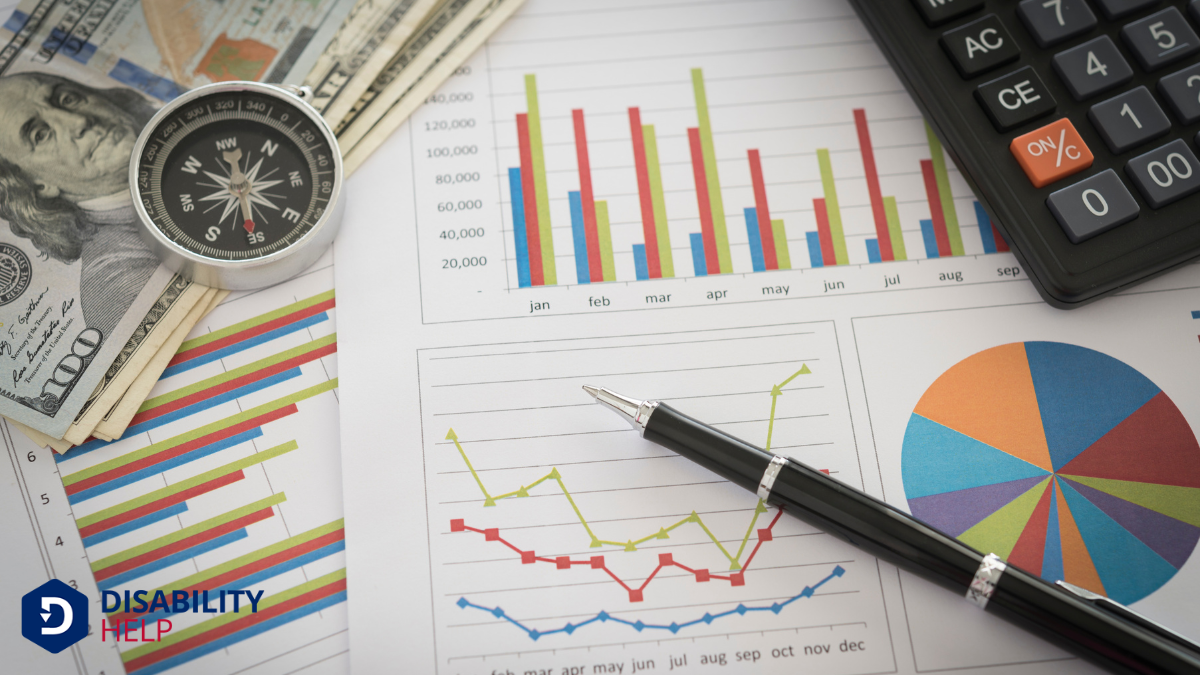Once you've received the good news about your SSDI approval, your thoughts naturally turn to back pay. But how long will it take for that money to actually reach you? The answer isn't straightforward, as several factors can influence the timeline. From the efficiency of your local Social Security office to the chosen payment method, many elements play a role. Curious to find out what to expect next?
Key Takeaways
- SSDI back pay is typically issued within 60 days after approval, but processing times can vary.
- Direct deposit may expedite the payment process compared to receiving a check.
- Contact the local SSA office for updates if back pay delays occur.
- Processing speed at the local SSA office impacts when back pay is received.
- Maintaining current contact information with the SSA ensures timely communication regarding payment status.
Understanding SSDI Back Pay
Understanding SSDI back pay is essential for anyone traversing the Social Security Disability InsuranceA form of insurance that provides income to individuals who are unable to work due to a disability. process. When you're approved for SSDI, you're entitled to receive back pay. This is the amount owed to you from the time you became disabled to when your benefits start.
It guarantees you receive the funds you would've gotten if your application had been approved sooner. Back pay isn't automatic; it requires understanding how the system calculates it. You're paid from your established disability onset date, minus the five-month waiting period.
Back pay can be a significant amount, depending on how long your application took to process. Knowing this helps you manage expectations and better plan your finances once you're approved. Understanding these details guarantees you receive what's rightfully yours.
Determining the Award Date

When you're figuring out your award date for SSDI back pay, start by calculating your onset date, which is when your disability began.
You'll need to understand the eligibility period, as this affects how much back pay you might receive.
Calculating Onset Date
Curious about how Social Security determines the start of your disability benefitsFinancial assistance provided to individuals who are unable to work due to a disability, such as Soc...? It all begins with calculating your onset date. This is the date when your disability became severe enough to prevent you from working. Getting this right is vital because it directly influences your back pay.
Here’s what you need to know:
- Medical Evidence: Your medical records and doctors' reports play a significant role in establishing this date.
- Work History: The last date you were able to perform substantial work is taken into account.
- Consultative Exams: Sometimes, Social Security requires additional medical evaluations to confirm your condition.
- Consistency: Make sure all information aligns across documents to avoid delays.
Understanding the Eligibility Period
After determining the onset date, the next essential step is identifying the eligibility period, which helps establish your award date.
You'll need to understand that your eligibility period starts five full months after your established onset date. This waiting period is mandatory and can't be waived, so benefits begin in the sixth month.
It's important to recognize that your award date is the first month you’re entitled to receive Social Security Disability Insurance (SSDI)A U.S. government program that provides financial assistance to individuals who are unable to work d... payments, not necessarily when you start receiving them. Back pay is calculated from this award date.
Keep in mind that the Social Security Administration considers various factors, such as reconsideration or appeal, which might influence the final award date.
Accurately determining these dates guarantees you receive the entitled benefits.
Factors Affecting Back Pay Timing
Several factors can influence the timing of your back pay after SSDI approval. Understanding these can help you anticipate when you might receive your funds.
First, the speed of your local Social Security office’s processing plays a significant role; some offices handle cases quickly than others.
Second, if you've had representationThe way people with disabilities are depicted in media, culture, and politics, often influencing pub..., such as a lawyer, their involvement can sometimes delay or expedite the process.
Third, your banking setup matters—direct deposit typically speeds things up compared to receiving a physical check.
Finally, any discrepancies or changes in your personal information can cause delays.
- Local office processing speed
- Involvement of legal representation
- Banking method (direct deposit vs. check)
- Accuracy of personal information
Calculation of Back Pay Amount
To calculate your SSDI back pay, you'll first need to figure out your eligibility start date.
Next, determine your monthly benefit amount, which will help outline your total back pay.
Remember to account for the mandatory waiting period, as this affects how much you'll receive.
Determining Eligibility Start Date
When determining your eligibility start date for SSDI back pay, understanding the calculation process is crucial. Your eligibility start date is often based on several factors, including when you initially applied for benefits and when you became disabled. The Social Security Administration (SSA) reviews your application details to establish this date.
Consider these key points:
- Onset Date of Disability: This is when you were first unable to work due to your condition.
- Application Date: The date you submitted your SSDI application.
- Five-Month Waiting Period: SSDI requires a mandatory five-month wait from the onset date.
- Retroactive Benefits: You may receive back pay for up to 12 months prior to your application date if you're eligible.
Understanding these factors helps guarantee you receive the back pay you're entitled to.
Calculating Monthly Benefit Amount
After understanding your eligibility start date, the next step is figuring out the amount you'll receive in back pay.
To do this, you need to calculate your monthly Social Security Disability Insurance (SSDI) benefit. The Social Security Administration (SSA) determines this based on your average indexed monthly earnings (AIME) over your working years. They apply a formula known as the primary insurance amount (PIA) to your AIME to arrive at your monthly benefit. The exact amount can vary depending on your work history and earnings.
Once you know your monthly benefit, multiply it by the number of months between your established onset date and the month you receive your first SSDI payment. This will give you an estimate of your total back pay.
Accounting for Waiting Period
Understanding the waiting period is essential when calculating your SSDI back pay. Typically, the Social Security Administration enforces a mandatory five-month waiting period after your disability onset date before you can receive benefits. This means you won't get paid for the first five months of disability, which affects your back pay calculation.
Consider these points:
- Onset Date: This is the date your disability began as determined by the SSA.
- Approval Date: The date your SSDI claim is approved can differ from your onset date.
- Waiting Period: Subtract five months from your onset date to determine your payable period.
- Back Pay Calculation: It's based on the months between your payable period and the approval date.
Understanding these elements guarantees you know what to expect in your back pay.
Impact of Retroactive Payments

Retroactive payments can considerably impact your financial situation by providing a much-needed financial cushion. When you receive these payments, they cover the period from your disability onset date to the approval date, minus the waiting period. This lump sum can help you catch up on overdue bills, settle debts, or manage essential expenses like rent and utilities.
It’s essential to plan wisely, so you don’t overspend this windfall. You might consider using some of the funds to build an emergency savings account. Having this safety net can give you peace of mind and reduce future financial stress.
Retroactive payments can also act as a bridge while you await regular Social Security Disability Insurance (SSDI) monthly benefits, ensuring you maintain financial stability.
Typical Back Pay Disbursement Timeline
Receiving a lump sum through retroactive payments can greatly ease financial burdens, but understanding when you'll actually see this back pay is equally important.
Typically, once your SSDI claim is approved, you could receive your back pay within a few months. Several factors influence this timeline:
- Processing Time: It varies depending on the Social Security Administration's (SSA) workload.
- Direct Deposit: Opting for direct deposit might expedite the payment process.
- Payment Schedule: Keep in mind that your back pay might align with your regular SSDI payment dates.
- Communication: Maintain regular contact with the SSA for updates and to address any potential issues.
Staying informed can help you anticipate when your financial relief will arrive, allowing you to plan accordingly.
Handling Delays and Issues
Even though you've been approved for SSDI, delays in receiving your back pay can be frustrating.
First, make certain your contact details are up to date with the Social Security Administration (SSA). Incorrect information can cause delays.
If you've waited longer than expected, contact your local SSA office to check on your claim's status. It’s also helpful to maintain detailed records of all communications.
If you're not getting clear answers, consider reaching out to your local congressperson’s office. They often have staff dedicated to assisting with federal issues like this.
Stay persistent but patient; processing times can vary.
Finally, verify there are no outstanding documents or information the SSA needs from you to proceed with your payment.
Financial Planning With Back Pay

Once you receive your SSDI back pay, it’s vital to handle these funds wisely and strategically. This money can greatly impact your financial stability if used correctly.
First, prioritize paying off any outstanding debts. Reducing liabilities can relieve stress and improve your financial health.
Next, consider setting aside funds for emergencies to provide a safety net for unforeseen expenses. Planning for the future is important, so investing in retirement savings can be beneficial.
Additionally, budgeting for monthly expenses guarantees you manage your back pay effectively.
Here's a list to guide your financial planning:
- Pay off outstanding debts: Reduce liabilities and gain peace of mind.
- Set aside emergency funds: Prepare for unexpected costs.
- Invest in retirement savings: Secure your future.
- Budget monthly expenses: Maintain financial stability.
Conclusion
Once you're approved for SSDI, receiving your back pay can take a bit of time, typically a few weeks to several months. Stay proactive by keeping in touch with the SSA to monitor the status of your payment. Make certain all your documentation is in order to avoid any unnecessary delays. While waiting, consider how you'll manage your finances with this back pay, so you're prepared when it arrives. Patience and preparation are key to steering through this process smoothly.






